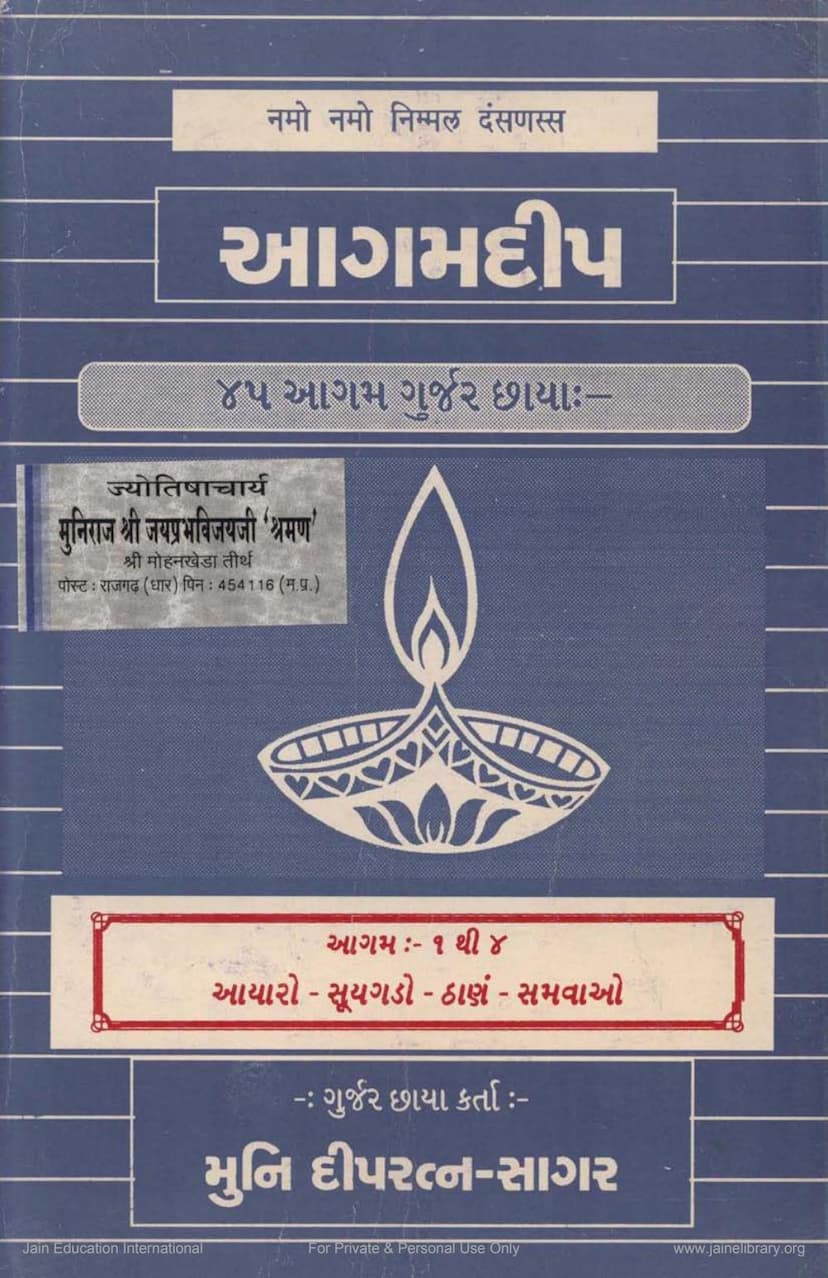Agam Deep 45 Anuogadara Gujarati Anuvaad
Added to library: September 1, 2025

Summary
This text is a Gujarati translation and commentary titled "Agam Deep 45 Anuogadara Gujarati Anuvaad" by Muni Dippratnasagar, published by Agam Shrut Prakashan. It is part of a larger series of Jain Agam publications.
The core of the text is a detailed explanation and commentary on the Jain scripture known as Anuogadarai (or Anuogadarai in its Prakrit form), which is considered the 45th and final Anga (limb) of the Jain Agamas. The commentary is referred to as "Gurjar Chhaya" (Gujarati Shadow/Commentary).
The text systematically breaks down the Anuogadarai, categorizing its content into various "Anuogadaras" (topics or discussions), identified by numbers and page ranges. These Anuogadaras cover a vast spectrum of Jain philosophy, cosmology, ethics, and practices.
Key themes and sections covered include:
- Knowledge (Gyan): Discusses the five types of knowledge in Jainism (Abhinibodhika, Shrut, Avadhi, Manahparyava, Kevala) and their characteristics.
- The Concept of "Aavashyak" (Essentials): A significant portion is dedicated to defining and explaining the different types of Aavashyak (Nama, Sthapana, Dravya, Bhava Aavashyak) and their nuances. It delves into the detailed classification of Dravya Aavashyak into Agam Dravya Aavashyak and No-Agam Dravya Aavashyak, further breaking them down into categories related to the body and other aspects.
- Shruta (Scriptural Knowledge): Explores the different types of Shruta (Nama, Sthapana, Dravya, Bhava Shruta) and their classifications.
- Skandha (Collections/Sections): Discusses the concept of Skandha, its various types (Nama, Sthapana, Dravya, Bhava Skandha), and their classifications.
- The Six "Upakrama" (Approaches/Methods): Details six ways of approaching a subject: Nama, Sthapana, Dravya, Kshetra, Kala, and Bhava Upakrama. It then extensively elaborates on these, providing numerous examples and sub-classifications.
- Anupoorvi (Sequential Order): Explains the concept of sequential order in various contexts, including Nama, Sthapana, Dravya, Kshetra, Kala, Utkirtana, Ganana, Samsthana, Samacharya, and Bhava Anupoorvi. This section is particularly extensive and detailed.
- Naya (Standpoints): Discusses the seven Jain logical standpoints (Nayas) such as Naigama, Sangraha, Vyavahara, Rjusutra, Shabda, Sambhirudha, and Evambhuta, and how they apply to understanding Jain principles.
- Pramana (Means of Knowledge): Explains the four types of Pramana: Dravya Pramana, Kshetra Pramana, Kala Pramana, and Bhava Pramana, with detailed sub-classifications and examples.
- The Concept of "Nam" (Names): A very elaborate section on different types of names and their classifications, including Ek Nama, Dvi Nama, Tri Nama, Chatur Nama, Panch Nama, Shath Nama, Sapta Nama, Ashtha Nama, Nava Nama, and Dasha Nama. This section delves into grammatical aspects and philosophical interpretations.
- Kshapan (Destruction of Karmas): Discusses various aspects of karma destruction.
- Aaya (Gain/Benefit): Explores the different types of gain, both worldly and spiritual.
- Sankhya (Numbers/Quantification): A substantial portion is dedicated to explaining various numerical concepts and their application in Jain cosmology and philosophy, including the complexities of defining "asankhyeya" (innumerable) and "ananta" (infinite) quantities.
- Chikitsa (Remedies/Treatment): Touches upon concepts related to remedies for karmic afflictions.
- Vyakhyana (Commentary/Explanation): The text itself is a commentary, providing explanations for the intricate terms and concepts within Anuogadarai.
The text is characterized by its meticulous detail, providing classifications, sub-classifications, and illustrative examples for each concept. It aims to offer a comprehensive understanding of the Anuogadarai for Gujarati-speaking Jain scholars and practitioners. The publication is supported by various donors, indicating a collective effort to preserve and disseminate Jain scriptures.